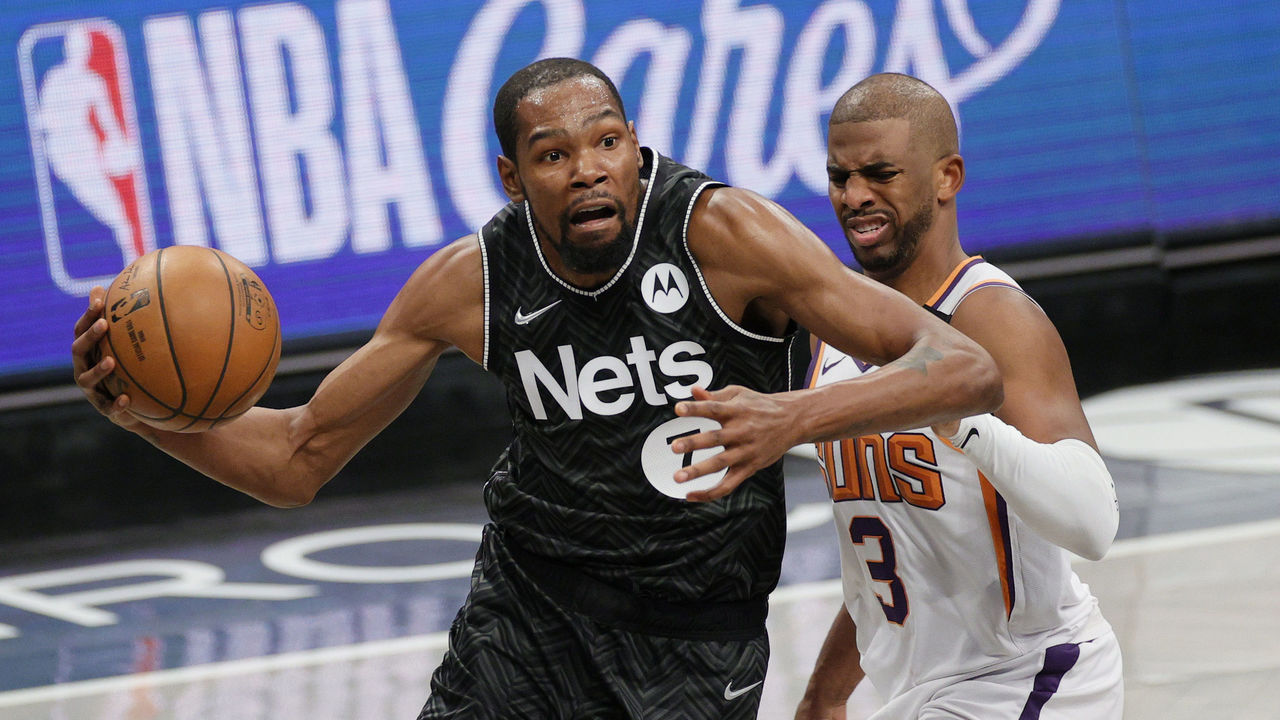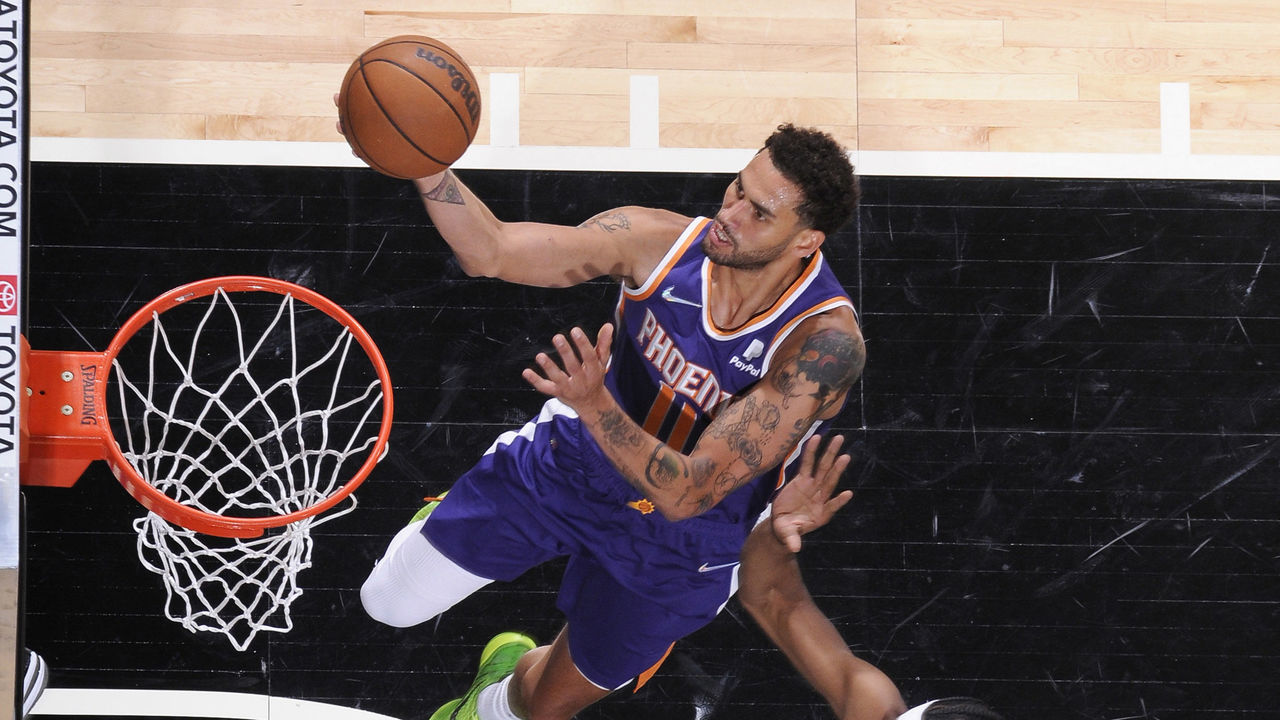Does getting to the rim matter as much as it used to?
Two of the three current best teams in basketball met Saturday when the Phoenix Suns paid a visit to the Nets in Brooklyn. The Suns prevailed, pushing their win streak to 16 games. The Nets, despite the loss, remain atop the Eastern Conference with wins in 12 of their last 15. And throughout the game, as they've done all season, both teams' offenses subsisted on a steady diet of mid-range jumpers and floaters.
Those in-between shots have partly come at the expense of threes - the Nets rank 14th and the Suns 25th in 3-point attempt rate - but, more than that, they've come at the expense of shots at the rim. Only the Mavericks have taken a lower share of their field goals within 4 feet of the basket (24.9%) than Brooklyn (26%) and Phoenix (27.5%), according to Cleaning the Glass.
The two teams' shot profiles, and their corresponding success, reflect a leaguewide trend. Average rim frequency this season is the lowest it's been since 2003-04. As recently as 2019-20, only one NBA team took under 30% of its shots at the rim. Just two years later, there are seven such teams. Five of those - the Suns, Nets, Hawks, Sixers, and Heat - rank in the top nine in non-garbage-time offensive efficiency.
The Nets can get away with it because they employ arguably the greatest mid-range shooter in the history of the sport. An underplayed aspect of Kevin Durant's return from a torn Achilles is that he barely gets to the rim anymore, and it's been underplayed because it hasn't affected his scoring efficiency at all. Despite the fact that a career-high 60% of his shots have been non-rim 2-pointers - shots on which the league collectively shoots 41% - Durant has a 65% true-shooting mark that ranks second in the NBA among non-centers and is personally bested only by his 66.6% clip last season.
Phoenix derives a large portion of its at-rim offense from center Deandre Ayton either diving out of the pick-and-roll or taking advantage of switches, but the team's ball-screen actions are primarily designed to create avenues for its guards to shoot pull-up jumpers. Those guards rarely - and in Chris Paul's case almost literally never - get to the rim. Paul has taken 214 shots this season and all but eight of them have come outside the restricted area, which is the lowest rim frequency for any qualified player in the NBA. Devin Booker gets to the hoop at a 27th-percentile rate for his position. And they're the highest-usage players for the league's sixth-ranked offense.

Does getting to the basket simply not matter as much as it used to?
Phoenix finished last in the NBA in rim frequency (27.2%) last season and came up just two wins short of the championship. The next-best Western Conference teams - the Jazz (29%) and the Clippers (29.4%) - also ranked bottom five during the regular season. Any of them could have realistically won the title with better injury luck, and each of them would've represented an anomaly if they'd done so. The champion with the lowest proportion of at-rim shots in the 19-year Cleaning the Glass database was the 2010-11 Mavericks at 30.6%. Even the dynastic Warriors teams that helped change the paradigm when it came to so-called jump-shooting teams succeeding in the playoffs got to the rim far more often.
This isn't a treatise on modern versus old-school basketball orthodoxy. The Moreyball revolution was about far more than just maximizing 3-pointers; it also emphasized the rim and the free-throw line and, more broadly, guided players toward the optimal spots on the court for their skill sets. Paul still took plenty of mid-range jumpers in Houston. He's always been good enough at those shots to make them viable high-volume half-court weapons.
Now, at 36 years old, without the burst to blow by even the slowest-footed of centers, Paul is leaning all the way into his mastery of the middle of the floor, and he's still managing to pull defenses out of their base coverages in the process. His elbow jumper is still scary enough to force opponents to put two on the ball, even at the risk of unlocking his surgical passing. His 10.1 assists per game lead the league and are the most he's averaged in seven years.
It's also worth noting that the Suns lost last year's Finals to a Bucks team that demolished them inside, and that the Lakers won the title the season prior as the league's best interior scoring team in the regular season and playoffs. While the correlation isn't exceedingly strong - championship teams on average have ranked 15th in rim frequency - only two teams on record have won it all after finishing in the bottom five. Why, then, are we seeing this leaguewide decline?

It's not that rim shots have become less valuable. On the contrary, a shot at the rim is significantly more likely to go in today (63.7%) than it was even 10 years ago (60.4%). That uptick is likely a product of both enhanced floor spacing and increased selectivity. In the past, when teams didn't hunt 3-pointers to the extent they do today, seeing extra bodies and arms at the rim might not have dissuaded a driver or post player from attempting a contested layup. Now, rim help is almost always interpreted as an invitation to find the open man on the perimeter. Even rolling big men are trained to kick to the corner rather than trying to power through guards pulling over to help from the weak side.
It's not just offenses becoming increasingly jumper-happy; it's also defenses becoming increasingly rim-conscious. Teams have grown more comfortable conceding long-range shots as a cost of barricading the basket - a defensive principle popularized by the 2018-19 Bucks and perpetuated (via dramatically different schemes) by recent iterations of the Raptors and Heat.
We've seen the proliferation of deep drop coverage, hyper-aggressive nail help, and myriad zones - schemes designed to either force the ball away from the middle of the floor or funnel it into pockets of space between the 3-point line and a towering rim protector. Rim shots may have become more valuable, but they've also become less available.
Here's a look at the trend lines of the league's shot profile over the last five years:
There are indications that the league's jump-shooting habits are beginning to stabilize. After a period of precipitous decline, long mid-range frequency plateaued two seasons ago at around 10%. And while the 3-point rate has continued to climb, its acceleration has slowed. Some of the league's redistributed rim shots have moved all the way out beyond the arc, but many have simply backed up a step or two to the short mid-range area (4-14 feet), otherwise known as "floater range." Those shots are increasingly popular counters to today's defensive schemes.
Back in 2016-17, an identical proportion of shots came from floater range and long mid-range. In the last two seasons, by contrast, the rate of floater-range attempts has been nearly double that of long mid-rangers. That's a fascinating shift because in a vacuum, short mid-rangers are no more valuable than long mid-rangers. In fact, the league has collectively shot better on long twos than it has from floater range in 10 of the last 12 seasons, including this one. But attempting floaters comes with benefits that aren't reflected in raw field-goal percentage.
While short middies once came from big men out of post-ups, they are now primarily lofted by guards on pick-and-roll drives. And many of those guards use the threat of the floater to disguise and open up lob passes to rolling bigs. Attempts from that area are also far more likely to result in free throws. Per Cleaning the Glass, 727 shooting fouls have been drawn from floater range this season, compared to 162 from long mid-range.
Phoenix, Brooklyn, Atlanta, Philly, and Miami - the aforementioned quintet of rim-averse teams producing efficient offense in spite of that aversion - are all top 12 clubs in floater-range frequency and accuracy, spurred by finesse guards like Paul, Booker, Trae Young, and Tyrese Maxey.
With the exception of the Heat, those are also all superb jump-shooting teams, which makes up for a lot. It means they can be selective about the shots they take at the rim in a way other teams can't. The Nets and Suns have all manner of counters for drop coverages and other paint-packing schemes. They're probably the best teams in the league at taking what defenses give them.

Teams with lesser shot-making capabilities don't have that luxury. Some have to bang their heads against the wall trying to get all the way to the cup, and their effectiveness suffers: Six of the top 10 teams in rim frequency this season rank bottom 10 in at-rim field-goal percentage. The Suns may not take a ton of shots at the rim, but when they do, they finish. Their blistering 68.1% conversion rate at the basket is good for fifth in the league. Miami and Philly aren't far behind.
And those teams are still plenty capable of exerting rim pressure. It's just that they tend to do so as a means of opening up clean looks elsewhere, either via drive-and-kicks or, in the Suns' case, skip passes that capitalize on Ayton's roll gravity. Not getting to the basket a ton tends to correspond with a low free-throw rate, but the Heat, Sixers, and Nets all get to the line at top-six rates.
Of course, those offenses still have room for improvement. It's fair, for example, to say the Suns should look for Ayton on the back end of switches more often, and that doing so would make their offense even more efficient. It's fair to expect the Sixers' shot profile to change for the better now that Joel Embiid is back. And it's fair to be concerned about the Nets' lack of north-south juice. James Harden was supposed to provide that, but he's getting to the basket less frequently than ever, even relative to the league's collective outward migration.
Brooklyn doesn't have a big man like Ayton or even a slashing wing like Mikal Bridges who can take some of the shot-making pressure off of their two star creators. Unlike the Suns, the Nets don't finish effectively on the rare occasions they venture all the way to the basket. (Harden's struggles, once again, are a big factor there.) But their collection of shooting is so overwhelming that it's easy to imagine them going the distance even if Harden doesn't fully rebound and Kyrie Irving doesn't return.
Getting to the rim obviously still matters a great deal, but the way the game has changed offensively and defensively has lowered the threshold for how frequently a title-contending team needs to get there, placing more importance on the ability to control other areas of the floor. Teams with shot profiles like Phoenix's and Brooklyn's haven't won it all in the past, but we're in a different era that could usher in a different kind of champion.
HEADLINES
- Kawhi drops career-high 55 points in Clippers' win over Pistons
- 26 stories we're most excited about for 2026 (Part 1)
- Raptors' Barnes joins Jokic as only active players with 20-25-10 game
- Luka, LeBron combine for 58 points as Lakers end 3-game skid
- Alvarado suspended 2 games, Suns' Williams gets 1 for on-court fight